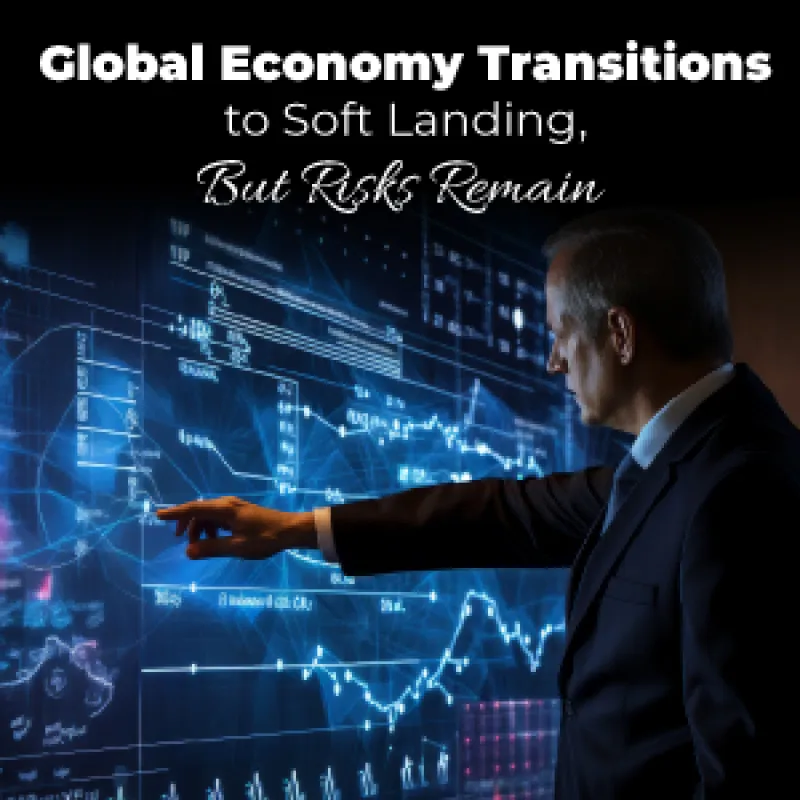Global Economy Transitions to Soft Landing, But Risks Remain
The clouds are starting to dissipate.
The global economy is starting its descent into soft ground, with inflation falling steadily and growth continuing. But while the pace of expansion remains slow, there could be volatility ahead.
Global activity remained resilient in the second half of last year as demand and supply factors mainly supported economies. In contrast, on the demand side, more robust private and public spending continued to sustain activity despite tighter monetary conditions. Despite geopolitical uncertainties, higher labor force participation, improved supply chains, and cheaper energy and commodity prices were effective on the supply side.
Of course, this resilience will continue. But if we look at the central forecasts, global growth will remain stable at 3.1 percent this year. According to October forecasts, it is expected to increase by 0.2 percentage points to 3.2 percent next year.
Significant divergences persist. Slower growth is expected in the United States, where tight monetary policy continues to weigh on the economy, and in China, where weak consumption and investment continue to weigh on activity. In the euro area, activity is expected to pick up somewhat after a difficult 2023, when high energy prices and tight monetary policy restrained demand, while many other economies are expected to show remarkable resilience, with growth accelerating in Brazil, India, and the major economies of Southeast Asia.
Inflation continues to fall. Excluding Argentina, global headlines suggest that inflation will fall by 0.4 percentage points to 4.9 percent this year compared to October forecasts (also excluding Argentina). Excluding volatile food (volatility is the fluctuation in the price of a particular product in financial markets over a certain period) and energy prices, core inflation is projected to decline, while headline and core inflation for advanced economies is expected to average around 2.6 percent this year, close to central banks' inflation targets.
Graphic 1
Since monetary tightening typically works by suppressing economic activity, the relevant question is: what role does monetary policy play, if any? The answer to this question suggests that monetary policy operates through two additional channels. First, the rapid pace of tightening helped convince people and companies that high inflation would not be allowed to take hold. This, in turn, prevented a sustained rise in inflation expectations, helping to dampen wage growth and reducing the risk of a wage-price spiral. Second, the unusually synchronized tightening has directly reduced headline inflation by reducing world energy demand.
Graphic 2
But uncertainties persist, and central banks now face two-sided risks. There is a need to avoid premature easing that would undo many hard-won credibility gains and lead to a rebound in inflation. However, interest rate-sensitive sectors such as the construction industry show increasing signs of strain, while lending activity has declined markedly. It will be equally important to move towards monetary normalization over time, as many emerging markets where inflation is downward have already started to do so. Please do so to ensure growth and avoid inflation falling below the target. In this sense, the US, where inflation is more demand-driven, needs to focus on the first category of risks. In contrast, the euro area, where rising energy prices play a disproportionate role, must manage the second. Of course, moving towards a soft landing will be challenging in both cases.
The biggest challenge ahead is tackling rising fiscal risks. Most countries with high public debt and borrowing costs emerged from the pandemic and energy crisis. Reducing public debt and deficits will free up space to cope with future shocks. In this context, emerging markets have shown more robust growth than expected, partly due to improved monetary and fiscal frameworks, and have become quite resilient with stable external balances. Nevertheless, policy divergences across countries may trigger capital outflows and exchange rate volatility. This calls for more substantial buffers in line with the Integrated Policy Framework.
The biggest challenge ahead is tackling rising fiscal risks. Most countries with high public debt and borrowing costs emerged from the pandemic and energy crisis. Reducing public debt and deficits will free up space to cope with future shocks. In this context, emerging markets have shown more robust growth than expected, partly due to improved monetary and fiscal frameworks, and have become quite resilient with stable external balances. Nevertheless, policy divergences across countries may trigger capital outflows and exchange rate volatility. This calls for more substantial buffers in line with the Integrated Policy Framework.
Beyond fiscal consolidation, the focus should turn to medium-term growth. Global growth next year is forecasted to be at 3.2 percent, well below the historical average. So, a faster pace is needed to address the world's many structural challenges, such as the climate transition, sustainable development, and raising living standards.
Research shows that reforms that ease the most binding constraints to economic activity, such as governance, business regulation, and external sector reform, can help unlock hidden productivity gains. More substantial growth (including, for example, the low-carbon technology products needed by emerging and developing countries) can only be achieved by removing trade barriers that impede trade flows between different geopolitical blocs and limiting geo-economic fragmentation.
Graphic 3
What is needed instead is for our economies to strive for greater interdependence. Only in this way can we work together on shared priorities. In this context, multilateral cooperation remains the best approach to addressing global challenges, and we welcome the progress recently made to increase the permanent resources of the Funds by 50 percent.




 Back
Back









